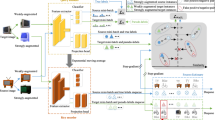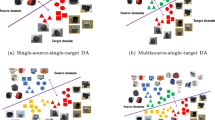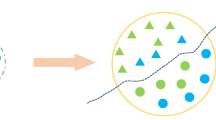Abstract
Unsupervised domain adaptation(UDA) methods based on optimal transport have been successfully used to improve cross-domain classification performance. Optimal transport aligns the distribution of source domain and target domain by minimizing the transport cost. However, the existing works based on optimal transport ignore the class-structure prior information of domains and do not adequately reflect the real data distribution. It always leads to be difficult in distinguishing target instances near the decision boundary. In this paper, we propose an end-to-end Attention-guided Optimal Transport (AOT) framework to achieve better domain adaptation. Concretely, first we introduce a weighted cost matrix based on the self-attention mechanism to reduce the bias caused by minibatch selection in training. It is realized by relating the prediction results in source and target domains. Meanwhile, a Jensen–Shannon divergence (JSD) regularization term is exploited to establish the mutual relationship between the feature space and the label space to achieve more reliable transport plan. Second, in order to enhance the discriminability of domain-invariant features using the class-structure prior, we also develop a pairwise metric learning strategy. It defines the positive/negative pairs by labels and enhances the class-structure prior by coupling feature and label similarities. Finally, we compare the proposed methods with ten SOTA approaches on multiple single source benchmarks and a multi-source benchmarks. The experimental results demonstrate that AOT achieves the best performance for classification tasks.







Similar content being viewed by others
References
Ajakan H, Germain P, Larochelle H (2017) Domain-adversarial neural networks. J Mach Learn Res 17(1):2096–2030
Balaji Y, Chellappa R, Feizi S (2020) Robust optimal transport with applications in generative modeling and domain adaptation. Adv Neural Inform Process Syst (NeurIPS) 33:12934–12944
Chen C, Chen Z, Jiang B, et al (2019) Joint domain alignment and discriminative feature learning for unsupervised deep domain adaptation. In: Proceedings of the AAAI conference on artificial intelligence, pp 3296–3303
Chen M, Zhao S, Liu H, et al (2020) Adversarial-learned loss for domain adaptation. In: Proceedings of the AAAI conference on artificial intelligence, pp 3521–3528
Chen W, Hu H (2020) Unsupervised domain adaptation via discriminative classes-center feature learning in adversarial network. Neural Process Lett 52(1):467–483
Chizat L, Peyré G, Schmitzer B et al (2018) Scaling algorithms for unbalanced transport problems. Math Comput 87:2563–2609
Courty N, Flamary R, Tuia D et al (2016) Optimal transport for domain adaptation. IEEE Trans Pattern Anal Mach Intell 39(9):1853–1865
Courty N, Flamary R, Habrard A et al (2017) Joint distribution optimal transportation for domain adaptation. Adv Neural Inform Process Syst (NeurIPS) 30:1640–1650
Damodaran BB, Kellenberger B, Flamary R, et al (2018) Deepjdot: Deep joint distribution optimal transport for unsupervised domain adaptation. In: European Conference on Computer Vision, pp 467–483
Deng Z, Luo Y, Zhu J (2019) Cluster alignment with a teacher for unsupervised domain adaptation. In: Proceedings of the IEEE/CVF international conference on computer vision, pp 9944–9953
Goodfellow I, Pouget-Abadie J, Mirza M et al (2014) Generative adversarial nets. Adv Neural Inform Process Syst (NeurIPS) 27:2672–2680
Gretton A, Borgwardt K, Rasch M et al (2012) A kernel two-sample test. J Mach Learn Res 13:723–773
Hamburger C (2021) T-svdnet: Exploring high-order prototypical correlations for multi-source domain adaptation. In: Proceedings of the IEEE/CVF conference on computer vision and pattern recognition, pp 9991–10,000
HassanPour Zonoozi M, Seydi V (2022) A survey on adversarial domain adaptation. Neural Process Lett. https://doi.org/10.1007/s11063-022-10977-5
Hauptman AG, Guoliang, Lu K (2019) Contrastive adaptation network for unsupervised domain adaptation. In: Proceedings of the IEEE/CVF conference on computer vision and pattern recognition, pp 4893–4902
He C, Tan T, Fan X et al (2023) Noise-residual mixup for unsupervised adversarial domain adaptation. Appl Intell 53:3034–3047
Khan S, Guo Y, Ye Y et al (2023) Mini-batch dynamic geometric embedding for unsupervised domain adaptation. Neural Process Lett 34:2063–2080
Li D, Yang Y, Song YZ, et al (2017) Deeper, broader and artier domain generalization. In: Proceedings of the IEEE international conference on computer vision (ICCV), pp 5543–5551
Li M, Zhai YM, Luo YW, et al (2020) Enhanced transport distance for unsupervised domain adaptation. In: Proceedings of the IEEE/CVF conference on computer vision and pattern recognition, pp 13,933–13,941
Lin J (1991) Divergence measures based on the Shannon entropy. IEEE Trans Inf Theory 37(1):145–151
Liu YB, Han TT, Gao Z (2019) Pairwise generalization network for cross-domain image recognition. Neural Process Lett 52:1023–1041
Long M, Cao Y, Wang J, et al (2015) Learning transferable features with deep adaptation networks. In: Proceedings of the 32nd international conference on international conference on machine learning, pp 97–105
Long M, Cao Y, Wang J, et al (2016) Deep residual learning for image recognition. In: Proceedings of the IEEE/CVF conference on computer vision and pattern recognition, pp 770–778
Long M, Zhu H, Wang J, et al (2017) Deep transfer learning with joint adaptation networks. In: Proceedings of the 34th international conference on machine learning, pp 2208–2217
Long M, Cao Z, Wang J et al (2018) Conditional adversarial domain adaptation. Adv Neural Inform Process Syst (NeurIPS) 31:1647–1657
Pan Y, Yao T, Li Y, et al (2019) Transferrable prototypical networks for unsupervised domain adaptation. In: Proceedings of the IEEE/CVF conference on computer vision and pattern recognition, pp 2234–2242
Peng X, Bai Q, Xia X, et al (2019) Moment matching for multi-source domain adaptation. In: 2019 IEEE/CVF international conference on computer vision (ICCV), pp 1406–1415
Perrot M, Courty N, Flamary R et al (2023) Mapping estimation for discrete optimal transport. Adv Neural Inform Process Syst (NeurIPS) 29:4197–4205
Qian J, Wong WK, Zhang H et al (2022) Joint optimal transport with convex regularization for robust image classification. IEEE Trans Cybern 52(3):1553–1564
Redko I, Habrard A, Sebban M (2017) Theoretical analysis of domain adaptation with optimal transport. In: Machine learning and knowledge discovery in databases, pp 737–753
Saenko K, Kulis B, Fritz M, et al (2010) Adapting visual category models to new domains. In: ECCV, pp 213–226
Saito K, Watanabe K (2018) Maximum classifier discrepancy for unsupervised domain adaptation. In: Proceedings of the IEEE/CVF conference on computer vision and pattern recognition, pp 3723–3732
Shen J, Qu Y, Zhang W, et al (2018) Wasserstein distance guided representation learning for domain adaptation. In: Proceedings of the AAAI Conference on Artificial Intelligence, pp 4058–4065
Sun B, Saenko K (2016) Deep coral: correlation alignment for deep domain adaptation. In: European conference on computer vision, pp 443–450
Sun H, Lin L, Liu N, et al (2021) Robust ensembling network for unsupervised domain adaptation. In: PRICAI 2021: Trends in Artificial Intelligence, pp 530–543
Tzeng E, Hoffman J, Zhang N, et al (2014) Deep domain confusion: Maximizing for domain invariance. Preprint at https://arxiv.org/abs/1412.3474
Tzeng E, Hoffman J, Saenko K, et al (2017) Adversarial discriminative domain adaptation. In: Proceedings of the IEEE/CVF conference on computer vision and pattern recognition, pp 2962–2971
Venkateswara H, Eusebio J, Chakraborty S, et al (2017) Deep hashing network for unsupervised domain adaptation. In: Proceedings of the IEEE/CVF conference on computer vision and pattern recognition, pp 5018–5027
Wang H, Xu M, Ni B, et al (2020) Learning to combine: Knowledge aggregation for multi-source domain adaptation. In: European Conference on Computer Vision(ECCV), pp 727–744
Wang M, Deng W (2018) Deep visual domain adaptation: a survey. Neurocomputing 312:135–153
Wang X, Han X, Huang W (2019) Multi-similarity loss with general pair weighting for deep metric learning. In: Proceedings of the IEEE/CVF conference on computer vision and pattern recognition, pp 5017–5025
Xiao N, Zhang L (2021) Dynamic weighted learning for unsupervised domain adaptation. In: Proceedings of the IEEE/CVF conference on computer vision and pattern recognition, pp 15,242–15,251
Xu R, Chen Z, Zuo W, et al (2018) Deep cocktail network: Multi-source unsupervised domain adaptation with category shift. In: Proceedings of the IEEE/CVF conference on computer vision and pattern recognition, pp 3964-3973
Xu R, Chen Z, Zuo W et al (2019) Domain generalization via model-agnostic learning of semantic features. Adv Neural Inform Process Syst (NeurIPS) 32:6450–6461
Xu R, Liu P, Wang L, et al (2020) Reliable weighted optimal transport for unsupervised domain adaptation. In: Proceedings of the IEEE/CVF conference on computer vision and pattern recognition, pp 4394–4403
Zhang H, Yang J, Xie J et al (2017) Weighted sparse coding regularized nonconvex matrix regression for robust face recognition. Inf Sci 394–395:1–17
Zhang H, Qian F, Shang F et al (2022) Global convergence guarantees of (a)gist for a family of nonconvex sparse learning problems. IEEE Trans Cybern 52(5):3276–3288
Zhao H, Zhang S (2018) Adversarial multiple source domain adaptation. Adv Neural Inform Process Syst (NeurIPS) 31:8568–8579
Zhao S, Wang G, Zhang S (2020) Multi-source distilling domain adaptation. National Conference on Artificial Intelligence. Association for the Advancement of Artificial Intelligence (AAAI) pp 12975–12983
Zhou Q, Wang S, Xing Y (2021) Unsupervised domain adaptation with adversarial distribution adaptation network. Neural Comput Appl 33:7709–7721
Acknowledgements
This work is supported by the National Key Research and Development Program of China (No. 2021YFA1003004)
Author information
Authors and Affiliations
Contributions
SY and YL conceived the proposed idea and supervised the experimental work. YZ implemented the method and carried out the experiments. All authors discussed the results and contributed to the final manuscript
Corresponding author
Ethics declarations
Conflict of interest
The authors declare that they have no conflict of interest.
Additional information
Publisher's Note
Springer Nature remains neutral with regard to jurisdictional claims in published maps and institutional affiliations.
Rights and permissions
Springer Nature or its licensor (e.g. a society or other partner) holds exclusive rights to this article under a publishing agreement with the author(s) or other rightsholder(s); author self-archiving of the accepted manuscript version of this article is solely governed by the terms of such publishing agreement and applicable law.
About this article
Cite this article
Li, Y., Zhu, Y. & Ying, S. Attention-Guided Optimal Transport for Unsupervised Domain Adaptation with Class Structure Prior. Neural Process Lett 55, 12547–12567 (2023). https://doi.org/10.1007/s11063-023-11432-9
Accepted:
Published:
Issue Date:
DOI: https://doi.org/10.1007/s11063-023-11432-9




